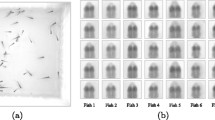Abstract
Based on optical image enhancement, this paper uses convolutional neural network to detect key points of swimming posture. In swimming posture analysis, key point detection can provide information about posture accuracy and evaluation. However, due to the change of illumination conditions, the reduction of image quality and occlusion, the accuracy and stability of key point detection are limited. In order to solve this problem, an optical image enhancement method based on convolutional neural network is proposed in this paper. First, a specific convolutional neural network architecture is used to extract features from input images. Then optical image enhancement technology is used to preprocess the input image to improve the image quality. Next, the trained convolutional neural network model is used to detect key points. Experimental results show that the proposed method has good performance under different illumination conditions and image quality. Therefore, this study provides a new idea and method for the application of optical image enhancement in the detection of key points in swimming posture analysis.




Similar content being viewed by others
Data availability
The data will be available upon request.
References
Bekhet, S., Alahmer, H.: A robust deep learning approach for glasses detection in non-standard facial images. IET Biometr. 10(1), 74–86 (2021)
Cosoli, G., Antognoli, L., Veroli, V., Scalise, L.: Accuracy and precision of wearable devices for real-time monitoring of swimming athletes. Sensors 22(13), 4726–4735 (2022)
Dalla Bernardina, G.R., Monnet, T., Pinto, H.T., de Barros, R.M.L., Cerveri, P., Silvatti, A.P.: Are action sport cameras accurate enough for 3d motion analysis? A comparison with a commercial motion capture system. J. Appl. Biomech. 35(1), 80–86 (2019)
Deng, F., Li, H., Wang, R., Yue, H., Zhao, Z., Duan, Y.: An improved peak detection algorithm in mass spectra combining wavelet transform and image segmentation. Int. J. Mass Spectrom. 465, 116601, 586–590 (2021)
Ferryanto, F., Nakashima, M.: Development of a markerless optical motion capture system for daily use of training in swimming. Sports Eng. 20, 63–72 (2017)
Gonjo, T., Olstad, B.H.: Race analysis in competitive swimming: a narrative review. Int. J. Environ. Res. Public Health 18(1), 69–75 (2021)
Hibberd, E.E., Laudner, K.G., Kucera, K.L., Berkoff, D.J., Yu, B., Myers, J.B.: Effect of swim training on the physical characteristics of competitive adolescent swimmers. Am. J. Sports Med. 44(11), 2813–2819 (2016)
Hong, D., Bang, S., Kim, B.: Unsupervised condition diagnosis of linear motion guide using generative model based on images. IEEE Access 9, 80491–80499 (2021)
Hou, J., Li, B.: Swimming target detection and tracking technology in video image processing. Microprocess. Microsyst. 80, 103535, 152–157 (2021)
Hsieh, Y.H., Huang, Y.C., Young, K.Y., Ko, C.H., Agrawal, S.K.: Motion guidance for a passive robot walking helper via user’s applied hand forces. IEEE Trans. Hum. Mach. Syst. 46(6), 869–881 (2016)
Jiang, L.: Research on auxiliary methods of swimming training virtual simulation technology based on embedded computer✰. Microprocess. Microsyst. 82, 103870–103874 (2021)
Kanmani, M., Narsimhan, V.: An image contrast enhancement algorithm for grayscale images using particle swarm optimization. Multimedia Tools Appl. 77, 23371–23387 (2018)
Kilgour, D.P., Hughes, S., Kilgour, S.L., et al.: Autopiquer—a robust and reliable peak detection algorithm for mass spectrometry. J. Am. Soc. Mass Spectrom. 28(2), 253–262 (2016)
Laudner, K.G., Wenig, M., Selkow, N.M., Williams, J., Post, E.: Forward shoulder posture in collegiate swimmers: a comparative analysis of muscle-energy techniques. J. Athl. Train. 50(11), 1133–1139 (2015)
Lyons, M.B., Keith, D.A., Phinn, S.R., Mason, T.J., Elith, J.: A comparison of resampling methods for remote sensing classification and accuracy assessment. Remote Sens. Environ. 208, 145–153 (2018)
Morales, A.T., Tamayo Fajardo, J.A., González-García, H.: High-speed swimsuits and their historical development in competitive swimming. Front. Psychol. 10, 2639–2644 (2019)
Robert-Lachaine, X., Mecheri, H., Muller, A., Larue, C., Plamondon, A.: Validation of a low-cost inertial motion capture system for whole-body motion analysis. J. Biomech. 99, 109520–109526 (2020)
Wang, Z., Wang, J., Zhao, H., Qiu, S., Li, J., Gao, F., Shi, X.: Using wearable sensors to capture posture of the human lumbar spine in competitive swimming. IEEE Trans. Hum.-Mach. Syst. 49(2), 194–205 (2019)
Zheng, F., Luo, S., Song, K., Yan, C.W., Wang, M.C.: Improved lane line detection algorithm based on Hough transform. Pattern Recognit Image Anal. 28, 254–260 (2018)
Zhu, J., Hu, J., Zhang, M., Chen, Y., Bi, S.: A fog computing model for implementing motion guide to visually impaired. Simul. Model. Pract. Theory 101, 102015–102020 (2020)
Funding
The authors have not disclosed any funding.
Author information
Authors and Affiliations
Contributions
Bin Xu has contributed to the paper’s analysis, discussion, writing, and revision.
Corresponding author
Ethics declarations
Conflict of interest
The authors declare that they have no competing interests.
Additional information
Publisher's Note
Springer Nature remains neutral with regard to jurisdictional claims in published maps and institutional affiliations.
Rights and permissions
Springer Nature or its licensor (e.g. a society or other partner) holds exclusive rights to this article under a publishing agreement with the author(s) or other rightsholder(s); author self-archiving of the accepted manuscript version of this article is solely governed by the terms of such publishing agreement and applicable law.
About this article
Cite this article
Xu, B. Optical image enhancement based on convolutional neural networks for key point detection in swimming posture analysis. Opt Quant Electron 56, 260 (2024). https://doi.org/10.1007/s11082-023-05875-6
Received:
Accepted:
Published:
DOI: https://doi.org/10.1007/s11082-023-05875-6




